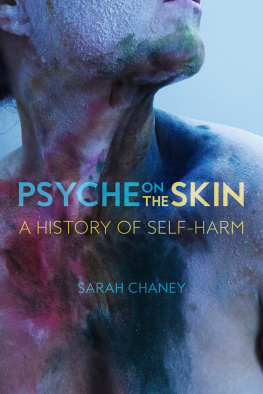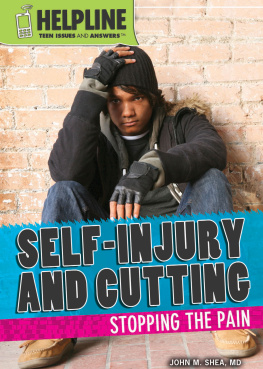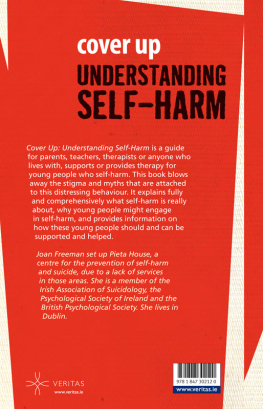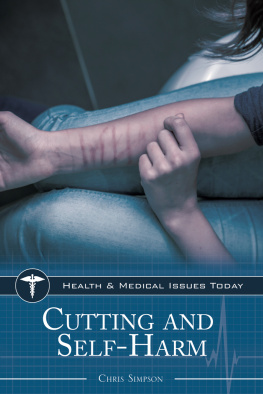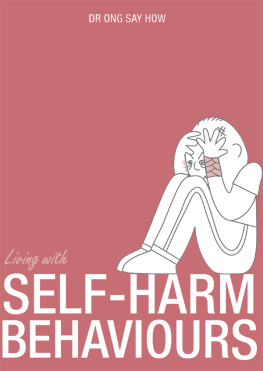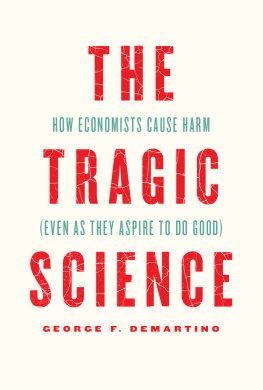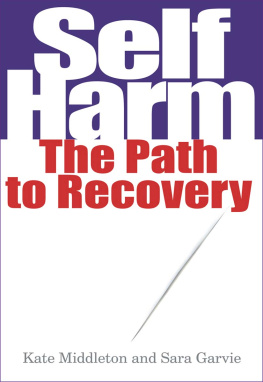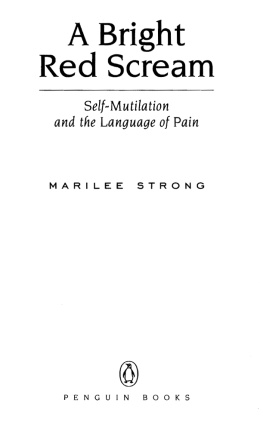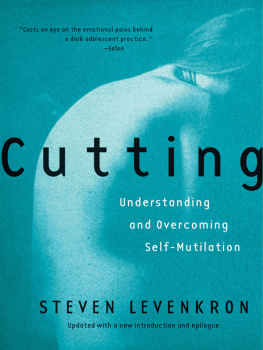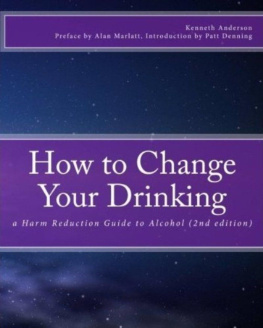PSYCHE ON THE SKIN


A HISTORY OF SELF-HARM
SARAH CHANEY
reaktion books ltd
With love to Gail, Holly, Tara, Shaz, Kate, Nat and all the forum folks old and new. I could never have got this far without you.
Published by REAKTION BOOKS LTD
Unit 32, Waterside
4448 Wharf Road
London N1 7UX, UK
www.reaktionbooks.co.uk
First published 2017
Copyright Sarah Chaney 2017
All rights reserved
No part of this publication may be reproduced, stored in a retrieval system, or transmitted, in any form or by any means, electronic, mechanical, photocopying, recording or otherwise, without the prior permission of the publishers
Page references in the Photo Acknowledgements and
Index match the printed edition of this book.
Printed and bound in Great Britain by TJ International, Padstow, Cornwall
A catalogue record for this book is available from the British Library
eISBN: 9781780237961
CONTENTS
1 THE PRE-HISTORY OF SELF-HARM: From Ancient
Castration to Medicinal Bloodletting
2 MORBID IMPULSE AND MORAL INSANITY:
The Emergence of Self-mutilation in Late Nineteenth-century
Psychiatry
3 SEXUAL SELF-MUTILATION: Masturbation, Masculinity
and Self-control in Late Victorian Britain
4 MOTIVELESS MALINGERERS: Multiple Personality,
Attention-seeking and Hysteria around 1900
5 FOCAL SUICIDE: Hypersexuality, Masochism and the
Death Instinct in Psychoanalysis
6 DELICATE SELF-CUTTING: Schizophrenia and the
Borderline in Post-war North America
7 TRIGGER HAPPY: Culture, Contagion and Trauma
in the Internet Age
INTRODUCTION
W hen I was in my early twenties, I determined to begin life anew. Filled with nervous optimism, I decided it was time to erase the visible evidence of my past. I had read about a scheme run by Samaritans. They offered free make-up matched to your skin tone, and advice on covering scars. The only catch? You had to be referred by your GP. I was living in my fourth home, and fourth London borough, in four years. The concept of a regular GP was alien to me. I got an appointment with the first doctor available. Id never met him before I dont even know if he was from my local practice or a locum, just passing through. Hesitantly, I explained what I needed from him. He stared at me in condescending disbelief. Why should I refer you? he said scathingly. Youll only go and do it again! In a decade or so of varied experience of primary care and mental health services, this is by no means the only occasion I have encountered hostility like this. Certainly, I have also experienced the reverse. Ill never forget the doctor who caught me up in his enthusiasm as he drew circles on a piece of paper to try and explain my mental state, or the accident and emergency nurse who talked kindly while she bandaged up a deep wound, even though it was past 1 a.m. and there was a two-hour wait for stitches. These experiences stand out, however, because they have been relatively unusual.
What is it about self-inflicted injury that invites knee-jerk assumptions? And, more importantly, where do such assumptions come from? It might The other implication of the words cited above is that it might be pointless to refer someone who presents with self-injury to other services, even at the patients request. This assumption is historically more recent than the idea of self-harm as manipulative, founded largely in the connections formed between self-injury and borderline personality disorder from the 1960s onwards. This notion has been retained in the modern concept of self-injury as an addictive behaviour, that once indulged in might be triggered by external circumstances and can never be truly recovered from.
My personal reflections also provide an important context for this book. The history of self-harm is not simply about the past, but offers a source of insight into modern medicine and cultural ideals. If we dismiss as a one-off instance the circumstances that might lead a busy GP to refuse point-blank to refer a patient to a charity service, we miss an opportunity to improve medical services. If we assume that it is just a bad psychiatrist who might reject anything else a patient tells them as unworthy of attention once they have admitted to self-harm, then we may fail to acknowledge our own prejudices and assumptions. Self-harm, it could be suggested, confounds the medical profession because it contradicts the efforts of practitioners to fix or heal a patient. Yet this simplifies a complicated moralization of self-injury, involving a variety of value judgements often made in comparison to other forms of behaviour.
Despite this background, however, in 2013 the fifth edition of the American Psychiatric Associations Diagnostic and Statistical Manual of Mental Disorders (DSM-5) incorporated non-suicidal self-injury (NSSI) as a category for the first time, as one of a number of conditions for further study. How many psychiatrists taking up the new category of NSSI, one wonders, would accept Musafars descriptions as culturally sanctioned and therefore not pathological?

Fakir Musafar (b. 1930), founder of the Modern Primitives movement, shown suspended from flesh hooks during a ritual.
Medical definitions have often been assumed to be neutral and objective in a way that personal experience is not. Yet, as this book shows, psychiatric definitions cannot be viewed outside the lives and experiences of medical practitioners. The political and cultural ideals we all hold impact the way our research is interpreted, whether we admit to this or not: a psychiatrist is no different in this respect from a mental health service user. Awareness of this is an important first step. Understanding our limitations improves our ability to critique. History itself is not a neutral set of ideas through which we understand the past, but an opportunity to reflect on our current experiences and practices. Viewing self-injury historically benefits practitioners and service users, taking us beyond a narrow model based either on personal experiences or medical theories. That does not mean we should ignore either of these things: indeed, they may well be the impetus that drives us to critique in the first place. Would I have been interested in exploring psychiatric models of self-harm if I had not wanted to understand my experiences of the medical profession better? If I had not wondered about those stereotypes and bitterly felt those assumptions? Perhaps I would, but the two things are impossible to disentangle. And if I pretend I can isolate either, I am only supporting the notion that objectivity might somehow be possible.
Rewriting psychiatry: countering the myth of objectivity
When I began my research, I held a number of preconceptions based on the work of other historians. I assumed that the emergence of a category of self-mutilation in Victorian psychiatry was part of a drive towards classification within mental health care at the time, based on a pessimistic and determinist biological model of mental illness. To assume that todays ideas are true in a way that yesterdays were not is to suggest that modern science is omniscient.
In this book I explore psychiatric models of self-harm, but I do not begin with them. In this way I hope to avoid some of the artificial distinctions that a focus on descriptions of self-inflicted injury as pathology can impose. While, in the main, I dont cover body modification, ritual mutilation or performance art, I do not consider that there is an obvious distinction between the self-harming behaviour described in a psychiatric context and wider instances of self-inflicted bodily harm. Yet for Victorian doctors and patients, self-cutting was much closer to self-treatment than other forms of self-injury, for bloodletting had been an established medical practice for over two thousand years.

